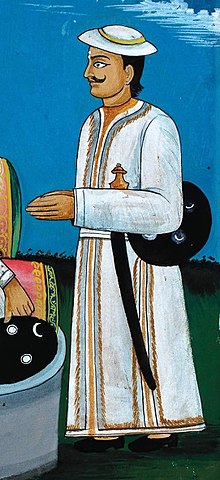Senapati Badabir Shivaram Singh Basnyat | |
|---|---|
| सेनापति बडावीर शिवराम सिंह बस्न्यात | |
 Senapati Shivaram Singh Basnyat consulting King Prithvi Narayan Shah | |
| Chief of Nepalese Army | |
| In office 1743 – February 1747 | |
| Preceded by | Prithivi Narayan Shah |
| Succeeded by | Kalu Pande |
| Personal details | |
| Born | Gorkha Kingdom |
| Died | Sangachok 1747 AD (12th Fagun 1803 B.S.[citation needed]) |
| Children | Naahar Singh Basnyat Kehar Singh Basnyat Abhiman Singh Basnyat Dhokal Singh Basnyat |
| Relatives | see Basnyat dynasty, Pande dynasty, Thapa dynasty |
| Military service | |
| Allegiance | Gorkha Kingdom |
| Rank | General |
| Battles/wars | Unification of Nepal |
Shivaram Singh Basnyat (Nepali: शिवराम सिंह बस्न्यात) was the military commander of Gorkha. After the conquest of Naldum area by the Gorkhalis, he along with Commander Bir Bhadra Thapa conquered Sanga, Panauti, Sankhu and adjacent areas.[1] They received fierce resistance from the Kantipur Kingdom at Sangachok.[2] He died in the defensive battle of Sanga Chowk during Unification of Nepal on 1803 B.S.[3][4]
He was born to Jayaram Singh Basnyat in the clan of Shreepali among Basnyats.[5] He had four sons - Naahar Singh Basnyat, Kehar Singh Basnyat, Abhiman Singh Basnet and Dhokal Singh Basnyat. His third son went on to become Supreme Commander of the Nepalese Army and Chief Minister (Mulkazi) in the Royal Court.[6]